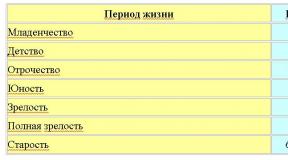What is open inflation? Types and types of inflation Classification of types of inflation
We invite you to familiarize yourself with such issues as the essence, types and causes of inflation. Agree, they are very relevant today. Levels of inflation, types of inflation, measures to combat it - all this has been actively discussed in recent years in connection with the current situation in the global and Russian economy.
What is inflation? This is a crisis state of a particular monetary system. This term itself arose in relation to money circulation in the mid-19th century. It was introduced in response to the massive issuance of paper dollars during the United States Civil War (1861 to 1865). Inflation, the causes, types and essence of which we are interested in, has long been understood as an increase in commodity prices and the depreciation of money. It was considered a monetary phenomenon. However, modern inflation is also associated with the general unfavorable state of development of the economy of a particular country, and not just with a decrease in the purchasing power of its monetary unit.
What does inflation lead to?
In an economy that is functioning normally, there should not be a significant increase in prices, that is, depreciation of money, meaning inflation. Inflation leads to a decrease in the purchasing power of money, as well as an increase in prices for services and goods. At the same time, prices for individual types are growing unequally.
"The Age of Inflation"
According to economists, civilized countries have entered the so-called “age of inflation” over the past 30 years. Today, inflation of 2-3% is considered a normal phenomenon of the global market economy.
Some causes of inflation with examples
Almost all countries have many reasons leading to inflation. However, in each case, the combination of factors in this process depends on specific economic conditions. For example, in Western Europe immediately after the end of World War II, inflation was associated with acute shortages of many goods. Subsequently, government spending, the wage-price ratio, the transfer of inflation from other countries, as well as some other factors began to play a major role in promoting this process. If we consider the former USSR, then here, along with some general patterns, one of the main causes of inflation in recent years can be considered a unique disproportionality that arose in the economy as a result of the functioning of the command-administrative system. Long development in wartime regime (according to some data, the accumulation rate reached half of the national income, while in Western countries it was only 15-20%), high degree of monopolization of the monetary system, distribution and production, low share of wages in the national income fees, as well as some other features were inherent in the Soviet economy.
Hyperinflation, galloping and moderate inflation
There are different types of inflation. The most common is the following three types:
- hyperinflation, in which prices rise by more than 200% per year;
- galloping inflation (per year from 20 to 200%);
- moderate, which is accompanied by their growth of no more than 10% per year.

Galloping, and even more so hyperinflation, is considered extremely undesirable. These types of inflation lead to severe economic and social consequences.
Suppressed inflation
There are other divisions. For example, there are such types of inflation as open and suppressed. Suppression is possible only under strict control by the state. It is characterized by demand-side inflation, which arises as a consequence of excess aggregate demand (aggregate expenditures) under conditions in which employment is close to full. Suppressed inflation thus manifests itself in worsening shortages of goods.
In our country, such a process was observed in the 80s. In addition to the deficit, during this period the inflationary process was also characterized by the fact that, at constant prices, the quality of products deteriorated, and unjustified shifts in the assortment were observed (a reduction in the production of cheap goods and an increase in the production of expensive ones). Instead of one imbalance at the beginning of the 1990s (few goods - a lot of money), another one arose. The shortage of money led to a drop in demand, and then to a decrease in production. The problem of non-payments has worsened. The state delayed the payment of wages to many people. It could also not fulfill its obligations for the supply of agricultural products and fuel, and for defense orders. Strict financial regulation has reduced investment and undermined incentives for output growth.

Types of open inflation
It distinguishes the following varieties:
- cost inflation;
- stagflation;
- inflation of adjusted expectations.
The first is characterized by an increase in wages, which drives up the rise in prices for services and goods (it significantly outpaces the growth of wages). Stagflation occurs when there is a simultaneous reduction in production volumes and an increase in prices. The last type of open inflation occurs when the economy is in a situation of constant expectation of rising prices. Because of this, consumers increase their consumption of services and goods, which means their prices rise.
Creeping, galloping and hyperinflation
The following types of inflation are also distinguished, depending on the rate at which prices in the market are growing.
- Creeping observed when the rate of price growth annually is 3-4%. It is typical for the economies of developed countries and is a stimulating factor for these countries.
- WITH galloping We encounter inflation when the average annual rate of increase in prices for services and goods ranges from 10 to 50% (sometimes reaching 100%). It predominates in developing countries.
- Hyperinflation observed when the rate of price growth increases annually by more than 100%. It is characteristic in certain periods of various states experiencing a radical change in their economic structure.
However, we have not considered all types and forms of inflation. We offer another classification of them.
Cost and demand inflation
The following types and types of inflation can be distinguished depending on the cause: inflation of production costs and demand. The latter is a functional type, characterized by an increase in aggregate market prices due to an increase in monetary demand for services and goods of the aggregate consumer (buyer), as well as its “separation” from the aggregate supply. It traditionally occurs when there is excess demand. Considering the types and types of inflation, we note that demand inflation can be due to various reasons.
Causes of demand inflation

It may be due to:
- Militarization of the economy, as well as increased military spending. The fact is that military products and military equipment do not function on the market. The state acquires it and then sends it to reserve. No money is required to service this product, since it does not change hands.
- Growing public debt and budget deficit. Either by issuing banknotes or by government loans, the budget deficit is covered. This creates additional funds for the state, and therefore additional demand.
- Also, demand inflation may be due to credit expansion of banks. The fact is that the expansion of the credit operations of these institutions leads to the fact that the credit instruments of circulation increase, which creates additional demand for services and goods.
- Another reason - influx of foreign currency into the country, which, as a result of its exchange for the monetary unit of a given country, causes an increase in the volume of money supply, and therefore increased demand.
Thus, demand-pull inflation occurs only when an increase in the price level occurs as a result of an increase in aggregate demand.
Let us now move on to consider cost-of-production inflation. Among its reasons are the following.
Causes of cost inflation

- Decreased labor productivity, which causes structural changes or cyclical fluctuations in production. They lead to higher unit costs, which means lower profits. This will ultimately affect the reduction in the volume of a particular production, which means a reduction in supply and, naturally, an increase in prices.
- Another reason - expansion of services, the emergence of new types with an increase in the share of wages and labor productivity, which is relatively low in comparison with production. This leads to a general increase in prices for various services.
- You can also highlight high indirect taxes included in the cost of goods, which means an increase in the overall level of costs.
- Another reason - increase in wages under certain circumstances(for example, an increase in the minimum wage). For such growth, companies are responsible for an inflationary spiral. Price increases, as well as new salary increases, follow the initial increase.
Measures to combat inflation
Surely you are interested not only in the main types of inflation, but also in how you can combat this phenomenon. The main ways to combat it are the following: anti-inflationary policies and monetary reforms.

Currency reform is a partial or complete transformation of the monetary system in the state, which takes place with the aim of strengthening and streamlining monetary circulation. The set of measures to regulate the economy that the state carries out in the fight against inflation is called anti-inflationary policy. Its main ways are as follows:
- regulation of money demand, using the tax and monetary mechanism by limiting the money supply, increasing the tax burden, increasing interest rates in lending, reducing government spending, which leads to a slowdown in economic growth;
- income policy, in which there is parallel control over wages and prices by completely freezing them or limiting their growth, the implementation of which can cause social contradictions.

So, you have learned what the levels of inflation are, its types and measures to combat it. Of course, inflation in the modern world is a very common phenomenon. Each of us involuntarily faces its consequences, whether we want it or not. Therefore, knowledge of topics such as the concept and types of inflation is necessary for everyone.
Inflation is a word that today has firmly entered the vocabulary of not only economists, but also ordinary people. And for the latter it is connected with all their troubles and misfortunes. Open inflation is when just yesterday the engineer Ivan Vasilyevich could afford to buy flowers for his wife on holidays, but today he can’t. He, as before, disappears from work and receives the same salary, but prices have increased. But another option is also possible. It occurs when the state actively intervenes in the economy in order to maintain prices. In this case, hidden inflation appears. But the consequences are still the same: people have to either tighten their belts or work more in the hope of maintaining the same standard of living. This multifaceted phenomenon, so familiar to all residents of our country, which literally screams about over the years, will be discussed in today’s article.
The concept and its essence
It is believed that open inflation, as well as its hidden variety, appeared immediately with the advent of money. To prevent this, the gold standard was invented. The stability of the metal content of dollars, francs, pounds sterling, rubles and yens was intended to provide statesmen and ordinary workers with the possibility of long-term planning. However, world wars gradually destroyed this connection with gold. After the adoption of the Jamaican monetary system in 1971, the dollar also lost its metallic content. Today, all currencies in the world are not backed by gold. Therefore, governments can uncontrollably increase the amount of money in circulation, which is why inflationary price increases occur. Thus, measures designed to solve the short-term financial problems of the state become the cause of a catastrophe, which is extremely difficult to prevent.
The term “inflation” first appeared in North America during the Civil War. Already in the 19th century it was actively used by scientists in Great Britain and France. However, this term became widespread only after the First World War. Inflation was talked about in connection with the sharp increase in the circulation of paper money. This phenomenon is characteristic not only of modern times, but also of the Russian Empire in 1769-1895, and the USA in 1775-1783. and 1861-1865, England - at the beginning of the 19th century, France - in 1789-1791, Germany - in 1923. If you look closely at each of these events, it becomes clear that the causes of open inflation often lie in huge costs associated with wars and revolutions. But today this phenomenon looks much larger. It is no longer periodic, but is a chronic problem not of individual regions, but of the whole world. Therefore, its definition has become much broader. Inflation is a complex socio-economic phenomenon that is associated with the overflow of money circulation channels beyond the needs of commodity circulation. And it cannot be reduced to a simple price increase. It is important that this unfavorable change in the environment is associated with inflationary reasons.

Measurement methods
The main problem in estimating inflation is that prices often rise very unevenly. Moreover, there is a category of goods whose cost does not change at all. Suppressed inflation is often not taken into account at all in statistical reports. But there are plenty of problems with assessing the open variety of this phenomenon. There are several indices that are used to measure inflation. Among them:
- Consumer price index. This is the most commonly used indicator. It helps estimate the cost of a basic “basket” of goods and services.
- Retail price index. When calculating this indicator, data on the 25 most important food products is used.
- Cost of Living Index. This indicator characterizes the real dynamics of household expenses.
- Wholesale producer price index.
- GNP deflator.
The indicator, which is calculated on the basis of a constant set of products, is called. Its main problem is that it does not take into account the possibility of changes in the product structure. The indicator, which is calculated on the basis of a changing set, is called the Paasche index. Its problem is that it does not take into account the possible decline in the level of well-being of the population. To eliminate the shortcomings of both indicators, there is a Fisher formula. This index is equal to the product of the previous two. Since open inflation is characterized by an increase in prices, there is a separate “rule of 70” that allows you to estimate the number of years before they double.

Evolution of ideas
Almost each of the economic schools has developed its own views on the problem of inflation. Often the differences lie in the causes of this negative phenomenon. Marxists believed that open inflation is characterized by a disruption of the process of social production under capitalism, which is manifested in the presence of banknotes in the sphere of circulation in excess of economic consumption. In their opinion, this problem is related to the internal contradictions of this social system. Inflation, open to monetarists, is too rapid a growth that simply cannot be kept up with the real expansion of production. However, all negative consequences are possible only in the short term. If we consider longer periods, then money is absolutely neutral. By doing so, they reject the basic postulate of the Keynesians that it is possible to constantly maintain a certain rate of economic growth through inflation. The basis for these arguments is the Phillips curve. It reflects the directly proportional relationship between unemployment and inflation. Thus, we can say that each of the economic schools has its own idea of the phenomenon under consideration. However, they are not antagonistic, but complement and continue each other.

Causes
Open inflation means that in the economy there is a discrepancy between the demand for money and the supply of goods. Such a disproportion may arise due to a state budget deficit, excessive investment, or faster growth of wages compared to the level of production. Open inflation can be caused by both external and internal reasons. The first include:
- Structural global crises, which are accompanied by rising prices for raw materials and oil.
- Negative balance of payments and foreign trade.
- Increasing the exchange of national currency for foreign currency by banks.
Internal causes of inflation include:
- Hypertrophied development of military engineering and other branches of heavy industry with a significant lag in the consumer sector.
- Disadvantages of the economic mechanism. This group of reasons includes the imbalance of income and expenses, monopolization of society, unreasonable increases in wages due to the active work of trade unions, “import” of inflation and unfavorable expectations of the population.
Tax and political causes of inflation are also distinguished. The first are associated with excessive fees from the state. The political reasons for inflation are due to the fact that the depreciation of money is beneficial for debtors, which is why it is often lobbied by them. Often, inflation in any given case is caused by a combination of various factors. Thus, in Western Europe after the Second World War it was associated with a shortage of a large number of goods, and in the USSR - with disproportionality in economic development.

Open inflation
There are two main types of the phenomenon under consideration. Open inflation manifests itself in a market economy. It is an indispensable attribute of the economy of most countries. The mechanisms of overt inflation include public expectations and the relationship between costs and prices. The reasons for this phenomenon have already been discussed above. The following types of open inflation are distinguished:
- Moderate (creeping). It is characterized by a relatively small increase in prices. Signs of open inflation in this case are practically invisible. Money does not depreciate, so a moderate price increase of 10-12% per year is sometimes considered even beneficial for the economy.
- This form is accompanied by a rapid jump in prices - from 20 to 200% per year. It does not stimulate production, but leads to increased unemployment and a fall in household incomes. Rosstat data show that this type was typical for the Russian Federation in the 1990s. A similar situation developed during this period in other countries of Eastern Europe.
- Hyperinflation. It is accompanied by an astronomical increase in prices (from 200 to 1000% per year, and sometimes more). If we consider all forms of open inflation, then this is the most dangerous. At the same time, there is a deformation of the sphere of production, the system of circulation of money and employment. The population strives to quickly get rid of money by buying real values with it. All existing social contradictions in society are aggravated, major political upheavals and conflicts become possible.
Inflation subdued
Let's consider the second type of this negative phenomenon. Let us immediately note that this situation is often typical for an administrative-planned economy. Hidden inflation appears where the state is actively fighting it. It is trying to freeze them at a certain level. Such measures cause a shortage of goods on the market. And this shows the obvious wrongness of the state’s actions. Instead of fighting the internal causes that led to a negative situation, it tries to eliminate its external manifestations. Therefore, government measures to freeze prices are always unpromising in the long term.
Other types
If we abstract from all the causes of inflation, we can say that it can be caused by imbalances in supply or demand. When equilibrium is established in the market, prices rise. Demand-pull inflation is caused by excess money supply in the economy. This situation is due to the fact that the incomes of the population and enterprises are growing too quickly, and the rate of increase in production cannot keep up with them. Supply inflation is associated with an increase in costs for firms that produce products. It is caused by an increase in nominal wages due to the work of trade unions and rising prices for energy and raw materials due to crop failures or natural disasters.
In addition to the types already listed, normal inflation is also distinguished. It is believed that it is a constant phenomenon that makes no sense to fight. On the contrary, price growth of 3-5% per year is the key to economic prosperity and stability.
From the point of view of the correlation of changes in the situation in various commodity markets, there are two types of inflation:
- Balanced. In this case, prices for different product groups remain unchanged relative to each other. This type of inflation is not terrible for business, because entrepreneurs always have the opportunity to increase the market value of their products.
- Unbalanced. In this case, prices for different groups of goods increase unevenly. It is dangerous for business. The cost of raw materials is rising faster than the price of final products. Therefore, there is a risk of loss of profitability. However, it is often impossible to make a forecast for the future. Thus, sometimes two types of inflation are distinguished separately depending on whether it is possible to predict the manifestation of this process in a certain period in the future.

Negative consequences
It has been established that normal inflation of 3-5% has a positive effect on the development of a market economy. However, when it gets out of control, it becomes the cause of a number of negative phenomena. Let's look at some of them:
- Inflation increases the social differentiation of the state's residents. It reduces opportunities for work and savings. People strive to get rid of money (the most liquid form of assets) by buying real values. And issuing securities does not always help to somehow stop this phenomenon.
- Inflation weakens the vertical and horizontal lines of power. Uncontrolled signs for solving urgent problems leads to an increase in public dissatisfaction with government agencies and a decrease in trust in them.
Also, the negative consequences of inflationary processes include:
- Disorder of the monetary circulation system.
- Creating tension in the financial sector.
- Explicit and hidden price risk.
- The rapid spread of natural exchange of goods.
- Low satisfaction of population demand.
- Reduced investment due to the riskiness of these operations.
- Changes in the structure and geography of income.
- Declining standard of living.
Anti-inflationary policy
The negative consequences of inflation lead to the fact that governments of various countries are forced to take measures at the level of state bodies to combat this phenomenon. Anti-inflationary policy includes a whole range of stabilization, monetary and budgetary measures. Each specific situation requires the use of a separate resolution mechanism. In accordance with the OECD concept, to overcome inflation it is necessary to focus on multivariate approaches. There are direct and indirect methods of combating this negative phenomenon. The first include:
- Distribution of loans by national authorities.
- Regulation of price levels by the state.
- Setting salary limits.
- Regulation of foreign trade by national authorities.
- Setting the exchange rate at the state level.
Indirect methods of combating inflation include the following measures:
- Regulation of the issue of banknotes.
- Setting interest rates for commercial banks.
- Regulation of required cash reserves.
- Operations on the open securities market conducted by the Central Bank.
The choice of certain measures is made under the influence of general economic conditions. There are three main options: income policy, supply stimulation and monetary regulation.

Domestic realities
The Russian type of inflation differs significantly from its foreign counterparts. This is due to the fact that it was formed under conditions of transition from an administrative-command to a market economy with high rates of price changes. Rosstat data indicate the following causes of inflation:
- Structural imbalances between the military-industrial complex and other industries. All processes in the economy did not meet standards, so time was needed for radical changes.
- High monopolization of the economy. Large companies themselves determine the price level, which does not correspond to the realities of a market economy.
- Militarization of the economy, a large army, a high level of development of the military-industrial complex. This has created a huge gap between the demand for consumer goods that the population needs and the actual supply of products.
- The huge scale of the state. This means that imports into Russia could not create a competitive environment.
If you look at how inflation arose in Russia over the years (taking into account the history of the USSR), then the first peak in modern history occurred during the First World War, the subsequent Civil War and the first stage of the NEP. The amount of money in circulation increased 84 times between 1914 and 1917. This was due to huge military expenditures. From 1917 to 1923, the money supply in circulation increased 200 thousand times. The second stage of inflation occurred already in Soviet times - during the period of the pre-war five-year plans and the Second World War. The third stage occurred after the collapse of the USSR - in 1992-1996.
Today, inflation is a global problem that affects all countries. It is caused by imbalances in the development of social production. The danger of inflation lies not only in the fact that it leads to a decrease in the standard of living of the population, but also in the fact that it undermines the ability to regulate the economy. In modern realities, this phenomenon has ceased to be episodic in nature, but has become a chronic disease of civilization. As for Russia, inflation here is caused by underinvestment, that is, by the incorrect efforts of the Ministry of Finance and the Central Bank. To combat it in domestic realities, it is necessary to support your manufacturer and introduce stricter price controls. To summarize, we can say that there is nothing wrong with normal inflation, but if this phenomenon gets out of control, it can lead to huge negative consequences.
Inflation (from the Italian “inflatio”, which means “inflation”) is a steady trend of growth in the general level of prices. Two concepts play an important role in this definition:
- stable rising prices. That is, inflation is a long-term process extended over time, so any short-term price jumps do not apply here;
- general price level. That is, we are not talking about an increase in all prices. The cost of certain groups of goods may remain unchanged or even decrease. We can talk about inflation if it increases general price index.
If we talk about the types of inflation, we distinguish: moderate, galloping, high, hypertrophied forms.
Types and types of inflation
Depending on the criteria, several groups of types of inflation can be distinguished.
For example, if you select the inflation rate as a criterion, the list will be as follows:
- moderate. The inflation rate is no more than 10%, usually 3-5% per year. Normal level for a modern economy;
- galloping. The rate of this type of inflation is expressed in double-digit percentages. Considered a major economic problem;
- high. Can be 200-300% or more. Typical for developing countries and countries with economies in transition;
- hyperinflation. Can reach more than 1000% per year.
If we choose the form of manifestation of inflation as criteria, we can distinguish such varieties as:
- Open. It manifests itself in the rise in prices, which we clearly see;
- Depressed. It manifests itself in the form of a shortage of goods when the government sets prices at a level below the equilibrium market level.
Open inflation
Open inflation is one of the types of inflation, which manifests itself in a general rise in prices. The open form does not introduce an imbalance into market mechanisms: rising prices in some markets are offset by their decline in others. This can be explained by the continued operation of market mechanisms that send price signals to the economy, stimulate the expansion of supply and production, and push investments.
Open inflation is a completely natural phenomenon in the world economy, which contributes to the development of markets, so there is no need to fight open inflation, but it must be kept under control, since an uncontrolled increase in the price level can weaken the economy.
Consequences of inflation
The consequences of inflation are manifested in both the economic and social spheres.
- In conditions of inflation, real incomes of the population decrease. People with a fixed income receive a particularly strong “blow,” since the same amount can buy fewer and fewer goods every month.
- Inflation leads to a decrease in real savings in the form of money, depreciating personal savings.
- Inflation contributes to social stratification.
- In conditions of inflation, a phenomenon such as a “flight” from money is often observed, which is an accelerated materialization of finance (money is quickly transferred into services and goods), which, in turn, stimulates production and contributes to economic development.
Causes of inflation
There are two clear causes of inflation:
- increase in aggregate demand. In this case we are talking about demand inflation. An increase in aggregate demand can lead to either an increase in any component of aggregate spending or an increase in the supply of money. The main reason for this type of inflation is an increase in the money supply;
- reduction in aggregate supply. It is the result of costs, which leads to stagflation, a simultaneous increase in the price level and a decline in production.
Hidden inflation
Hidden inflation is one of the types of inflation in which prices and incomes of the population remain unchanged, but there is an increase in the money supply or production costs. In other words, it is the gap between government-set and market prices.
Hidden inflation is a consequence of strict government control of markets. If the state sees that rising prices can lead to catastrophic consequences, it suppresses it: but in this case we are talking about eliminating the consequences, not the causes, and often ends in a shortage of goods: it is simply unprofitable for producers to produce and sell goods at prices below their adequate cost .
Commodity inflation
In most countries of the world, commodity inflation is the most important macroeconomic indicator that determines investment and consumer demand, interest rates, exchange rates, and many social aspects, including the quality and cost of living.
The state’s ability to keep inflation at an optimal level allows us to speak about the efficiency of the economy in the country, about a fairly high degree of development of self-regulation mechanisms, about the dynamism and stability of the economic system. Inflation at an optimal level (up to 10% per year) is useful for the country’s economy, as it stimulates commodity-money relations, the production of various goods, and so on.
Economic inflation
Economic inflation is always accompanied by rising prices, but rising prices are not always a form of inflation. Prices may rise due to crop failure, cyclical fluctuations, energy crisis, and so on.
The reasons for inflationary price increases include monopolistic price races, covering the state budget deficit with the help of additional money issues, inflationary expectations, and so on.
In the global economy, two parameters are traditionally used to describe the level of inflation: the gross national product deflator and the consumer price index.
Story
In the history of the world economy, there have been two cases of abrupt growth in prices associated with a fall in the cost of precious metals.
- After the discovery of America, a lot of gold and especially silver began to flow into European countries from Mexico and Peru. In the 50 years since the beginning of the 16th century, silver production increased more than 60 times. This caused an increase in commodity prices by the end of the century by 2.5-4 times.
- After the development of Californian (and then Australian) gold mines began in the late 40s of the 19th century. At the same time, gold production increased more than 6 times, and prices increased by 25-50%. This type of inflation has been observed throughout the world.
The rise in prices as a result of the influx of large quantities of gold and silver is directly related to the emergence of the quantity theory of money, according to which an increase in the amount of money in circulation causes an increase in prices. In reality, an increase in the money supply reflects a decrease in the value of precious metals, since the value of goods is expressed in more gold or silver.
Causes of inflation
The mechanism of inflation:
- The total volume of goods that can be purchased with the money supply available in a given economic system may grow more slowly than the volume of the money supply, or even decrease - in this case, the cost of goods increases, and the value of money decreases.
- The ratio of the volume of goods and the volume of money is not directly related, but takes into account the speed of turnover of the money supply in a given system. With an increase in the speed of money turnover, this will be equivalent to an increase in the money supply without changing the commodity supply.
The level of inflation is significantly influenced by the volume of money supply withdrawn from direct consumption through long-term investments that do not provide for quick returns, the level of deposits held in banks, the value of the refinancing rate, and so on.
In economics, the following causes of inflation are distinguished:
- An increase in government spending, to finance which the state resorts to money emission, increasing the money supply beyond the needs of commodity circulation. This is most pronounced during war and crisis periods.
- Monopoly of large firms on determining prices and their own production costs, especially in the primary industries;
- The monopoly of trade unions, which limits the ability of the market mechanism to determine the level of wages acceptable to the economy;
- A reduction in the real volume of national production, which, with a stable level of money supply, leads to an increase in the rate of inflation, since the same amount of money corresponds to a smaller volume of goods and services;
During particularly strong inflations, such as in Russia during the Civil War, or Germany in the 1920s. monetary circulation may generally give way to natural exchange. There are examples when government policy led to a long period of declining retail prices while increasing wages (for example, in the USSR in the last years of J.V. Stalin’s life and under the government of L. Erhard in West Germany starting in 1948).
Significant inflation (ten percent or more per year) indicates economic problems in the state. Quite often, severe inflation, also called hyperinflation (the level can reach thousands and even tens of thousands of percent per year) occurs due to the fact that the government issues an excess amount of banknotes to cover the budget deficit.
For modern economies, in which the role of money is played by obligations that have no intrinsic value, minor inflation is considered the norm and a necessity and is usually at the level of several percent per year. Inflation rates typically rise slightly at the end of the year, when both household consumption and corporate spending rise.
Types of inflation
Inflation is the process of depreciation of money as a result, for example, of the overflow of commodity circulation channels with the money supply. Inflation results from macroeconomic instability when aggregate demand exceeds aggregate supply. Uneven price growth across product groups creates inequality in profit rates and stimulates the outflow of resources from one sector of the economy to another (in Russia, from industry and agriculture to trade and the financial and banking sector). There are modern theories of inflation that allow us to determine its types: open inflation and suppressed inflation. Open inflation is characterized by macroeconomic disequilibrium in the direction of demand, in which the real value of money falls. Types of open inflation:
- Demand inflation - is generated by an excess of aggregate demand compared to the real volume of production. (Shortage of goods)
- Supply (cost) inflation means an increase in prices caused by an increase in production costs in conditions of underutilized production resources. Increasing unit costs reduces the volume of products offered by manufacturers at the existing price level.
- Balanced inflation - prices of various goods remain constant relative to each other.
- Unbalanced inflation - the prices of various goods change in relation to each other in different proportions.
- Projected inflation is inflation that is taken into account in the expectations and behavior of economic entities.
- Unpredicted inflation comes as a surprise to the population, since the actual growth rate of the price level exceeds the expected one.
- Adapted consumer expectations are a phenomenon associated with the deformation of consumer psychology. Extremely increased demand for goods allows entrepreneurs to raise prices for goods. (Demand creates supply).
Suppressed inflation is characterized by external price stability (with active government intervention), but an increase in the shortage of goods, which also reduces the real value of money.
Depending on the growth rate, there are:
- creeping(moderate) inflation(price growth less than 10% per year). Western economists consider it as an element of normal economic development, since, in their opinion, slight inflation (accompanied by a corresponding increase in the money supply) is capable, under certain conditions, of stimulating the development of production and the modernization of its structure. The growth of the money supply accelerates payment turnover, reduces the cost of loans, contributes to the intensification of investment activity and the growth of production. The growth of production, in turn, leads to the restoration of equilibrium between the commodity and money supply at a higher price level. The average inflation rate in EU countries in recent years has been 3-3.5%. At the same time, there is always a danger that creeping inflation will escape state control. It is especially great in countries where there are no proven mechanisms for regulating economic activity, and the level of production is low and is characterized by the presence of structural imbalances;
- Galloping inflation(annual price increase from 10 to 50%). It is dangerous for the economy and requires urgent anti-inflationary measures. Predominant in developing countries;
- Hyperinflation (prices rise at an astronomical rate, reaching several thousand percent per year, or over 100% per month). It paralyzes the economic mechanism and causes a transition to barter exchange. It is also characteristic of countries in certain periods when they experience a radical change in their economic structure.
The expression is also used chronic inflation for long-term inflation. Stagflation call the situation when inflation is accompanied by a drop in production (stagnation).
Agflation
Main article AgflationEconomists from the investment corporation Goldman Sachs have come up with a new term to describe the sharp rise in prices for agricultural products: "Agflation"(agricultural inflation). High rates of agflation have been recorded for two years in a row. In 2006, the Goldman Sachs food price index increased by 26 percent. In 2007, its growth was 41 percent.
Methods for measuring inflation
The most common method of measuring inflation is the Consumer Price Index (CPI), which is calculated relative to a base period.
Notes
see also
- The Rule of Seventy is a way to intuitively estimate inflation rates.
Links
- Official consumer price indices and average prices of goods and services
- Current graph of rising prices for goods in Moscow based on automated data collection.
- Inflation calculator from 1800 to 2008 English.
- Inflation // Economic dictionary.
- Inflation risk - article on an information site about risks.
- Belyaev Mikhail Ivanovich Inflation.
- Koryavtsev P. M. Inflation and the crisis of the Russian economy
- Koryavtsev P. M. Inflation and the crisis of the Russian economy: ten years from now
- Semenov V.P. Inflation: A Metric of Cause and Effect. - 1st ed. - M.: Russian Economic Academy named after G.V. Plekhanov, 2005. - 383 p. - ISBN 5-94506-120-4
- In 2008, inflation in Zimbabwe amounted to 231 million percent per annum
- Summary table of inflation indices in Ukraine (Ukrainian)
Wikimedia Foundation. 2010.
Types of inflation. Inflation classification criteria.
Depending on the degree of government intervention in the sphere of commodity-money relations, open and suppressed inflation are distinguished.
Open inflation is characteristic of countries with a market economy, where there is a free interaction between supply and demand and the excess of demand over supply leads to rising prices. Open inflation is characterized by a constant increase in prices. This is due to the mechanism of adaptive inflation expectations, demand inflation, cost inflation, and tax inflation. Seeing constantly rising prices, consumers increase demand at the expense of savings. Moreover, the continuing rise in prices confirms the correctness of their decisions and makes adaptive expectations more stable. Excessive demand leads to a reduction in savings, which affects the volume of credit resources, and this, in turn, slows down the growth of investment, and therefore the growth of supply, further aggravating the situation.
The basis of open inflation is the wage-price spiral. Higher-
falling prices inevitably leads to higher wages in order to maintain the well-being of workers and prevent a fall in their real incomes. And an increase in wages leads, in turn, to a further increase in demand, an increase in production costs and, as a consequence, an increase in prices. The rise in prices of goods and services requires another revision of wage rates. An inflationary spiral is unfolding, which is becoming more and more difficult to stop with each new round.
The development of open inflation is facilitated by the state establishing high tax rates on profits. Entrepreneurs have difficulty investing; they often prefer to invest money in a bank rather than in production, which leads to a decrease in the volume of production of goods and services, an imbalance of supply and demand, and rising prices. In turn, entrepreneurs can respond to tax increases by raising prices.
Based on the above, we can conclude that open inflation is characterized by:
An imbalance between aggregate demand and aggregate supply;
Constantly increasing prices;
The action of the mechanism of adaptive inflation expectations of demand and cost inflation, tax inflation.
Open inflation distorts the market, but it is less dangerous and curable with the help of government anti-inflationary measures.
Suppressed inflation is characteristic of an economy in which there is strict control over prices and incomes, which prevents inflation from manifesting itself openly in rising prices. Externally, prices do not change, but the amount of money in circulation has increased, which will naturally lead to an imbalance between the money supply and its commodity coverage.
Suppressed inflation is characterized by the establishment of strict controls over prices and incomes, temporary freezing of prices and incomes and, as a consequence, commodity shortages. Since price incentives do not work, investment volumes are reduced, production is reduced, and therefore supply is reduced. Suppressed inflation manifests itself in shortages of goods and services. The weakening dependence of prices on demand deprives entrepreneurs of the opportunity to correctly identify and direct investments.
Often the distribution of labor, material and financial resources is not optimal, and there remains a persistent underproduction of goods in demand. A chronic shortage of goods gives rise to another surge in demand, and the greater the deficit, the greater the size of current demand, which makes suppressed inflation sustainable.
Suppressed inflation is characterized by:
Establishing strict control over prices and incomes;
Temporary freezing of prices and incomes;
Constant shortage of goods and services.
Suppressed inflation is more dangerous: while open inflation distorts the market, suppressed inflation destroys it.
Suppressed inflation can only be stopped with maximum permissible price freedom.
The types of inflation considered do not exhaust their diversity. Depending on the rate of price growth, the following types of inflation are distinguished:
- moderate inflation– prices rise by less than 10% per year, the purchasing power of money remains unchanged. As practice has shown, with moderate inflation the economy can develop normally;
- galloping inflation– average annual price growth rate of 10-100%. Money materializes quickly. This inflation is dangerous for the economy and requires anti-inflationary measures;
- hyperinflation– prices rise quickly, the discrepancy between prices and wages becomes catastrophic, the level of well-being falls, large enterprises become unprofitable, people tend to turn money into goods, and a transition to barter exchange takes place. It is almost impossible to conduct business in these conditions; the main task is to survive by simplifying production, reducing external relations, and switching to natural exchange.
From the point of view of balancing prices for various groups of goods, they distinguish balanced And unbalanced inflation. With balanced inflation, the prices of various goods relative to each other do not change. Balanced inflation is not very dangerous even for small businesses. The risk of loss of income is not great. Unbalanced inflation is characterized by a constant change in the prices of various groups of goods relative to each other. It is very dangerous for business, fraught with high costs of the adaptation plan and does not make it possible to predict the future of the business.
Since it is difficult to predict that product groups that are leaders in price growth will remain leaders in the future, it is impossible to determine more profitable areas for investing capital and to calculate the profitability of various investment options.
Depending on the state’s ability to predict inflation, there are predictable and unpredictable inflation.
Projected inflation– this is inflation, which is taken into account in the expectations and behavior of the population, this is inflation for which the population is more or less prepared.
If the country's population assumes that inflation this year will be 12%, then nominal and real interest rates, rents, and wage growth will be adjusted upward by 12%.
Adjustment of nominal incomes can be carried out taking into account the Fisher equation i= r – π, where i, r – nominal and real interest rates, π – level of expected inflation.
At inflation rates > 10%, the Fisher equation looks like:
i – π
With inflation projected as shown above, income earners can take steps to reduce the negative effects of inflation on income.
Projected inflation does not have such a detrimental effect on economic efficiency or the distribution of income and wealth. The price in this case is only a signal by which economic entities adjust their behavior. But it leads to an increase in the inflation tax, a decrease in efficiency in its pure form, an increase in the average amount of cash, a reduction in real balances, and an increase in demand for durable goods.
Projected inflation dictates the need for constant revision of prices, leading to incorrect allocation of resources due to the impact of inflation on the tax system.
Unpredictable inflation– this is inflation that was unexpected for the population or appeared when the population did not have time to adapt to it.
Instability in the development of inflation complicates forecasting price levels and interest rates even in the near future. If the instability of both the level and fluctuations of inflation increases, it becomes even more unpredictable.
In conditions of unpredictable inflation, there is a redistribution of wealth from creditors to debtors. And since the creditors are most often households, they suffer losses, while firms and the state benefit. Unpredicted inflation leads to a redistribution of income between different segments of the population, this is due to the reaction of wages to rising prices.
Unpredictable inflation leads to declines in all types of fixed income. Those economic agents whose nominal incomes increase faster than the average price level find themselves in a better position.
Governments that have accumulated significant public debt often pursue policies to stimulate short-term inflation, which contributes to the relative depreciation of debt.
If economic agents have diversified sources of income, then they can simultaneously “win” and “lose” in conditions of rising inflation.
Many economists and theorists highlight gradual and rapid inflation. Gradual inflation refers to inflation, which manifests itself in an increase in the price level by two, three, five percent per year for a long time. Moreover, it should be noted that with gradual inflation, not only the scale of growth is low, but also the rhythm of inflationary price growth.
In addition, prices for some goods may rise, while others remain stable; For some goods prices rise faster, for others – slower.
A situation may arise in the economy. When an increase in the general price level occurs with a simultaneous reduction in production. The state of the economy, which is characterized by a simultaneous rise in prices and a decrease in production, is called stagflation.
The reasons for this phenomenon are various. Firstly, a reduction in supply associated with rising costs, i.e. cost inflation. Secondly, the structural imperfection of the market, the power of monopolies in the market, the lack of competition. Third, inflation expectations.



















